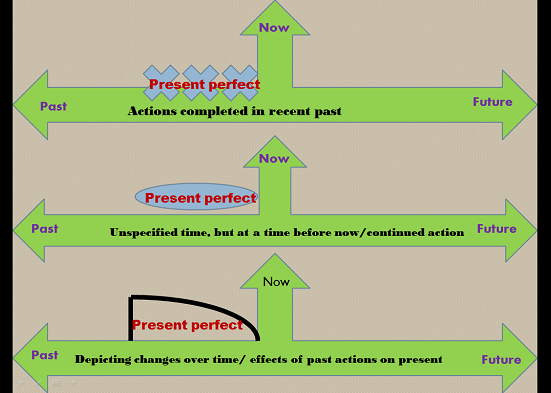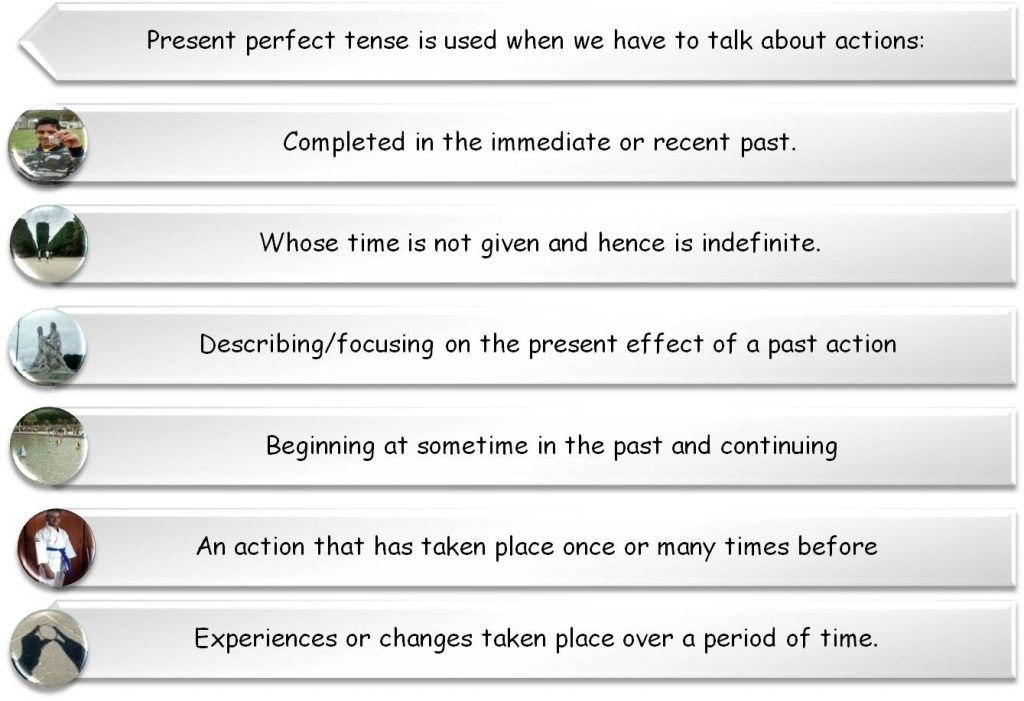Present Tense Vs Present Perfect Tense Vs Present Continuous Tense
4 Simple Present, Present Continuous, and Present Perfect
Simple Present, Present Continuous, and Present Perfect
Annapurna Madhuri
Any action or an event that started in the recent past and express idea of completion or occurence, without an exact time of its completion is expressed in the present perfect tense. Present perfect tense is also used for actions completed in the recent past, not very long time ago.
The present perfect tense form of a verb has two parts:
- The present tense form of 'to be' – known as helping verb or auxillary verb
- Past participle form of the main verb.
The structure of the sentence:
Affirmative sentences:-
Subject + helping verb + main verb + object
subject+ have/has + main verb (in past participle form) + object
Example: I have finished my work.
Interrogative sentences:-
Helping verb + subject + main verb + object
Have/has + subject + participle form of main verb + object
Example: Have I finished my work?
Negative sentences:-
Subject + helping verb + NOT – main verb + object
Subject + have/has NOT + participle form of main verb = object
Example: I have not finished my work.
At the end of this chapter, all learners will be able to
- Use auxiliary (helping) verbs with the past participle form of the base verb.
- Distinguish between usage of simple present and present perfect forms of verbs.
- Use verbs in present perfect tense in affirmative, interrogative and negative sentences.
- Arrange the words in the proper order to form good sentence structure.
The paragraph given below summarizes experiences of my visit to Vishakapatnam. Actions in this paragraph relate to an event that took place in the recent past. Read carefully and note the usage of present perfect tense in the passage.
I have been to Vishakapatnam most times during the last few months, I have been there on some official work several times. After I have completed my official work, I had some time to go around and see places around. I have done many things. I visited Bheemili beach, Rushikonda beach and Totlakonda beach, but experiences at the Rushikonda beach have been the best. Last month I had been to Vizianagaram. There I visited the Bhogapuram beach resort. I played tennis and swam in the pool. I have taken my Telegu classes since I have been on regular visits to Vishakapatnam. I have learnt a lot of Telugu now. I have written several small paragraphs and read it out to the class. I finally met my uncle who stays in Vishakapatnam. I have not seen him for a long time. I have just received a new dress from him. I have had some of the most relaxing times during my stay in this smart city in Andhra Pradesh.
Present perfect tense is used when we have to talk about:
- Actions indicating activities completed in the immediate or recent past.
- Past actions whose time is not given and hence is indefinite.
- Actions describing/focusing on the present effect, rather than the action (which has happened in the past) itself.
- Actions beginning at sometime in the past and continuing until the present time
- An action that has taken place once or many times before
- Experiences or changes taken place over a period of time.

Note: Present perfect is never used with words indicating past time – yesterday, last night, last week and so on
Past participles forms are formed
-
By adding 'ed', 'd', 't', to the present tense form of verbs.
walk – walked
laugh – laughed
want – wanted
believe – believed
build – built
2. By changing the structure of the present tense verb.
sell – sold
bring – brought
buy – bought
catch – caught
seek – sought
Summing up:

Signal Words:
just, often, a lot, constantly, always, forever (affirmative sentences)
never, ever (in interrogative sentences)
so far, yet, till now (in negative sentences)
for (when time period is indefinite), since (when time period is finite/definite (in phrases)
Simple present, present continuous, present perfect: Differences
Interrogative and Negative sentences in present perfect tense
Exercise: Change to interrogative sentences
Exercises: Change to negative sentences
- Choose the correct form of the verb –
- Drag/drop –
- Arrange in the proper order.
Source: https://kpu.pressbooks.pub/effectiveenglish/chapter/simple-present-present-continuous-and-present-perfect/

0 Response to "Present Tense Vs Present Perfect Tense Vs Present Continuous Tense"
Post a Comment